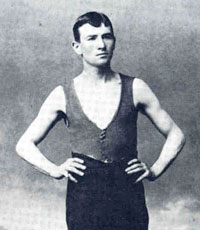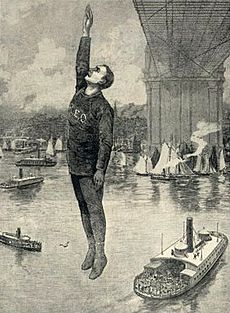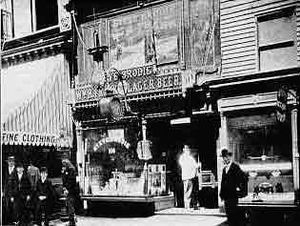Steve Brodie (bridge jumper) facts for kids
Quick facts for kids
Steve Brodie
|
|
|---|---|

Steve Brodie, c. 1885
|
|
| Born | December 25, 1861 Manhattan, New York City, U.S.
|
| Died | January 31, 1901 (aged 39) San Antonio, Texas, U.S.
|
| Occupation | Actor |
Steve Brodie (December 25, 1861 – January 31, 1901) was an American from New York City. On July 23, 1886, he claimed to have jumped off the Brooklyn Bridge and survived. This famous jump, though some people doubted it, made Brodie very popular. It helped him open a successful saloon and start a career as an actor. Before this, he had lost a lot of money and was quite poor.
Brodie's fame lasted long after he died. He was shown in movies, and a new saying, "to do a Brodie," became popular. This phrase means to take a big chance or a leap of faith. In the 1890s, people even compared Brodie to a famous British diver named Tommy Burns.
Contents
Steve Brodie's Early Life and Rescues
Brodie was born in New York City, on the east side of Bowery. His father had died just three days before he was born. Steve grew up in the area, selling newspapers and shining shoes.
When he was young, he was known for saving people from the water. He once rescued two young women who fell from a boat. He also saved an actress named Miss Jennie Rhett, who gave him a gold locket for being so brave.
Steve Brodie's Famous Bridge Jump

The Brooklyn Bridge, then called the East River Bridge, had opened only three years before Brodie's claimed jump. Sadly, a swimming instructor named Robert Emmet Odlum died trying the same stunt in May 1885.
By July 1886, Brodie had lost a lot of money. He claimed his jump from the bridge was from a height of about 135 feet. This is as tall as a 14-story building! The New York Times newspaper reported that the jump was from about 120 feet.
The Jump and Its Witnesses
The New York Times supported Brodie's story. They said he practiced by jumping from other bridges and ship masts. Two reporters supposedly saw him jump into the East River, feet first. He came out unhurt, though he felt some pain. After the jump, he was put in jail.
The Times described Brodie as a "newsboy" who jumped to win a $200 bet. This amount would be worth much more money today. Other stories said he was a bookmaker, someone who takes bets.

One story says a store owner named Isaac Meyers encouraged Brodie to jump. Brodie had told Meyers he wanted to be famous. Another account says a liquor dealer offered to help Brodie open a saloon if he jumped and survived.
Was the Jump Real?
If Brodie's jump was real, he would have been the first person to jump off the Brooklyn Bridge and survive. However, many people doubted his story. Some claimed that a dummy was thrown from the bridge instead. They said Brodie just fell out of a rowboat nearby.
Other Daring Jumps by Steve Brodie
On November 9, 1888, Brodie jumped from the Poughkeepsie Railroad Bridge. This jump was from a height of 222 feet into the Hudson River. He earned $500 for this stunt. Reports from that time disagree on whether he was seriously hurt or not. Soon after, he said he would "not try bridge-jumping again."
In 1889, Brodie was arrested when he dived off Horseshoe Falls at Niagara Falls. A judge in Canada said he would let Brodie go if he denied making the jump. Brodie first denied it, but then he changed his mind. He told the judge, "No, I'd rather rot in jail than swear to a lie. I did go over the falls. Do with me as you please." Some people questioned this feat too, which made him very angry.
Brodie Compared to Other Divers
In the 1890s, Brodie was often compared to Tommy Burns, a top British diver. Some newspapers suggested that Burns's dives were much more impressive than Brodie's.
Steve Brodie's Acting Career
After his famous jump, Steve Brodie became an actor. He used his reputation to appear in musical shows called vaudeville. He was in shows like Mad Money and On the Bowery. He also opened a saloon in Buffalo, New York.
Steve Brodie's Personal Life
After his Brooklyn Bridge jump, Brodie opened a saloon at 114 Bowery in New York City. This saloon also became a small museum about his bridge-jumping stunt. It even had a paper signed by a boat captain who claimed to have pulled Brodie from the water.
Brodie was known for being very generous. In the tough times of the 1890s, he gave away food like bread, sausages, and coffee from his cafe. Thousands of people who were poor or homeless benefited from his kindness.
Steve Brodie's Death
Steve Brodie died in San Antonio, Texas, on January 31, 1901. His family was with him. The cause of his death was described as either diabetes or tuberculosis.
He left $100,000 in his will. Most of his money went to his oldest daughter, Irene. It was held for her until his other two children were old enough. Then, the money was shared equally among all three. He left behind his wife, two daughters, and one son.
Steve Brodie in Popular Culture
Brodie became a popular symbol of the Bowery area of New York. He appeared in musical shows himself, and his character was used in many films about old New York.
He starred in a play called On the Bowery, which opened in 1894. A copy of Brodie's saloon was the setting for part of the play. Brodie even sang a song in it! The play ended with Brodie jumping off the bridge.
In 1933, actor George Raft played Brodie in the movie The Bowery (film). This movie told a made-up story about Brodie's dive. Years later, an actor named John Stevenson even used Brodie's name as his stage name.
Steve Brodie is also mentioned in other movies. In the 1946 film The Dark Corner, a taxi driver talks about someone falling and says he "[n]ever saw anyone ever pull a Brodie and bounce." He's also referenced in the 1947 film The Sin of Harold Diddlebock.
In 1949, Warner Brothers released a cartoon called Bowery Bugs. In this cartoon, Bugs Bunny tells an old man the story of Steve Brodie's jump. Bugs even winks at the audience at the end!
A Broadway musical from 1965 called Kelly (musical) was inspired by Brodie's story. It ends with the main character completing a dive.
The phrase "taken a Brody" has also appeared in books. It means to take a big risk or to jump from a high place. Authors like Thomas Pynchon and David Foster Wallace have used this phrase in their novels.
See also
 In Spanish: Steve Brodie (siglo XIX) para niños
In Spanish: Steve Brodie (siglo XIX) para niños


